Going back in time to try and understand the present is becoming a #PrussiaGate fascination. Every new article seems to lead to more pathways requiring research. There is a lot more we intend to present that will hopefully shed even more light on the ‘horrible invisible enemy’ and expose the evil currently waging war upon humanity.
The Evolution of Slavery series was an incredible journey as we saw how the methods of control that were used way back in history are still being deployed today. In Evolution of Slavery Part I and II, we presented how members of the Hanseatic League had transformed into some of the world’s largest banks and trading houses through a process of systemic and generational chain migration into Great Britain. By the mid-1600s, the Hanseatic League was vanishing from public view. This decline not only coincided with the rise of the kingdom of Prussia, but also a major ‘change of the guard’ within the British monarchy.
https://truthtrench.org/?p=3687&preview=true.
To the disgust of many at the time, Britain was ruled by a Catholic King and Queen. Rebel Protestant nobles found this an unacceptable predicament, and took matters into their own hands. Through the Dutch Ambassador in England, they made contact with Prince William of Orange, and kindly requested that he invade England. In return for a successful invasion, the nobles would invite William to become the King of England, Scotland and Ireland.
On November 5, 1688, William III of Orange and his navy arrived in Devon with up to 20,000 men. In what was known as the ‘Glorious Revolution’, the man of Orange declared his intentions for the British people:
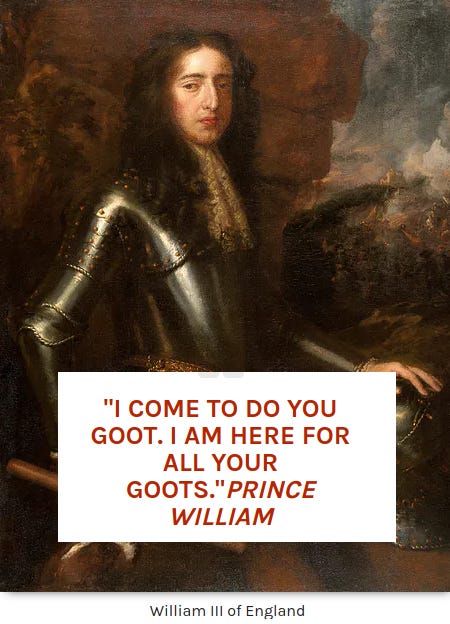
“William had achieved the remarkable feat of heading the first successful invasion of England since his namesake William the Conqueror in 1066.”
Under William III of Orange’s rule, the Bank of England was formed, and the British monarch has remained with German nobility to this very day. By 1871, every German noble pledged their loyalty to the newly-crowned Kaiser of Germany – Wilhelm I, from the House of Hohenzollern, the king of Prussia, and the prince of Orange.
With the recent passing of Queen Elizabeth II, the world has been forced to watch the British Crown. During this time, we felt compelled to acknowledge the transfer of the Crown to King Charles III. This series is an ode to the ‘Prussian Pickle’.
All in the Family
Charles is a keen student of his family’s ancestry, and for good reason. His lineage is a fascinating journey back in time and reveals much about the monarchy.
Cousins by the Dozen
#PrussiaGate has repeatedly contended that the ‘horrible invisible enemy’ we now face morphed into a complex matrix of central banks and globalist corporations after WWII, and is now openly coordinated through the World Economic Forum and controlled via international treaties. These corporate entities are managed and controlled by a shadowy group of private equity managers, hedge funds, and key personnel within the companies. It is hard to know exactly who owns or controls what, but what we do know is this corporate conglomeration owns and controls most of the world’s resources and supply chains, and they make huge profits by engaging nation-states in extortionary contracts.
The most recent example was seen in the enormous profits made by ‘Big-Pharma’ (Pharmaceutical Industrial Complex) following the Chyna virus and their gene therapy injections, which were mandated by a large number of governments around the world:
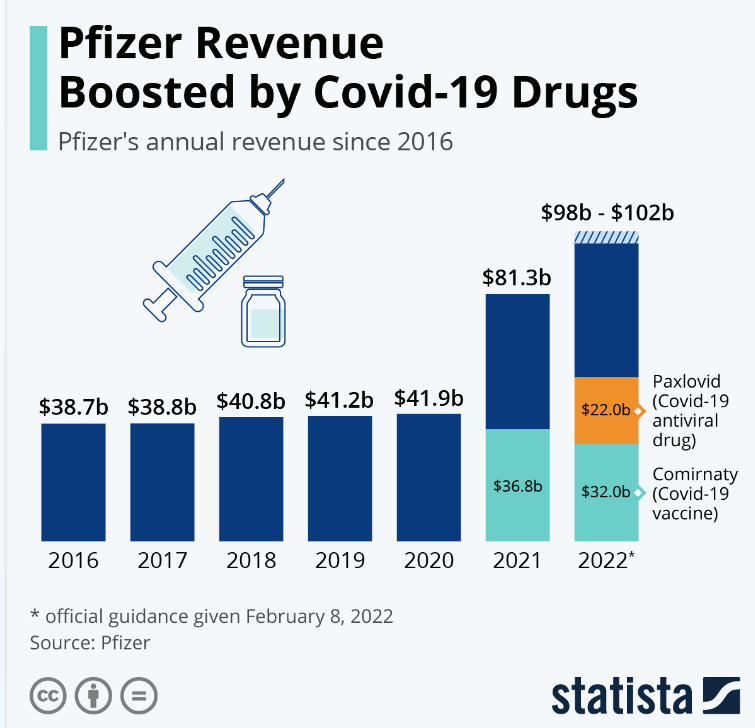
Before this invisible enemy mastered the art of using corporations to manipulate governments, it was using monarchies. In their mind, ‘We the People’ must always be controlled, but new means of control were needed to ensure the people remained blind to their captivity.
Just as it is impossible to know who really controls the complex matrix of global corporations, which we’ve referred to as the ReichsWEF, it is equally impossible to know who really controlled the monarchies of Europe over the last millennia. There is good reason why we refer to this enemy as invisible!
Research into monarchies reveals that European royal families were very familiar with inter-marrying, cross-breeding and covert infiltration. Keeping ‘it all in the family’, the off-spring of ruling monarchs would be promised to other royal families who, in many cases, were first cousins.
In order to consolidate power, it was considered necessary to ‘manage’ the royal lineage. As a consequence, many royal families across Europe are heavily related to one another. As the modern medical profession is now aware, the cost of inbreeding can be catastrophic. Notwithstanding, it seemed that the Royals had to work it out on their own:
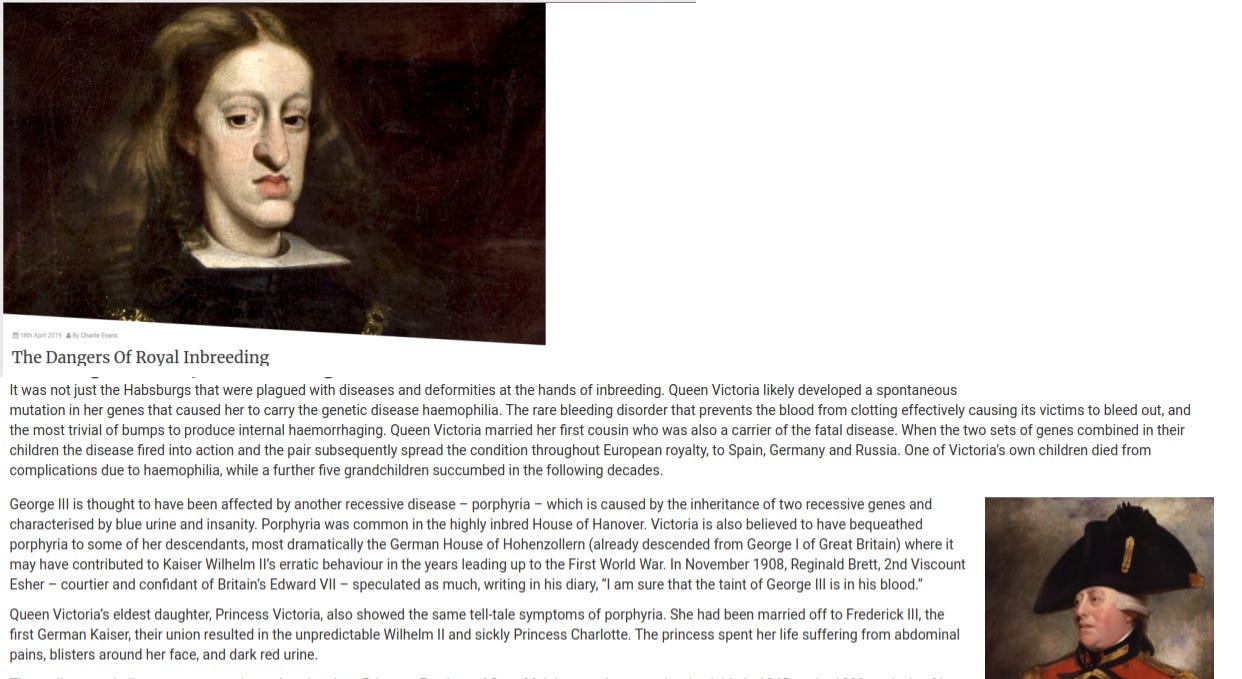
The evidence uncovered about the monarchs within Prussia, reveal how intertwined the British royal family is with the House of Hohenzollern. This is not a hidden secret, but it is remarkable how close the German House of Saxe-Coburg Gotha, now known as the House of Windsor, is to the House of Hohenzollern:
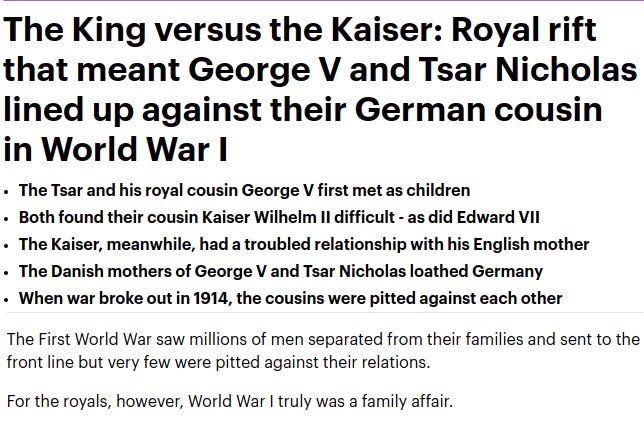
As noted in the article above, George V and Kaiser Wilhelm II shared the same grandparents in Queen Victoria and Prince Albert, of Saxe-Coburg Gotha.
Queen Victoria was the last monarch from the House of Hanover and she was the grandmother to George V and Kaiser Wilhelm II. Interestingly, she is also the great-great-grandmother to the recently-passed Queen Elizabeth II and her husband Prince Philip. The birth of Charles and his siblings was essentially a genetic reunion of Queen Victoria.
In the overall scheme of human evolution, WWI was a catastrophe, which we outlined in our Not Since 1917 series. Another point in time where humanity faced much bloodshed was in 1776, during the American Revolution. The King of Great Britain at the time, was King George III. The King of Prussia was Frederick the Great. They shared the same grand-father in King George I, meaning they were first cousins.
If we keep going back in time, we come to find a lady who gave birth to ten children, and is the direct lineage of Queen Victoria and King George III. This lady is Magdalene, from the House of Hohenzollern.
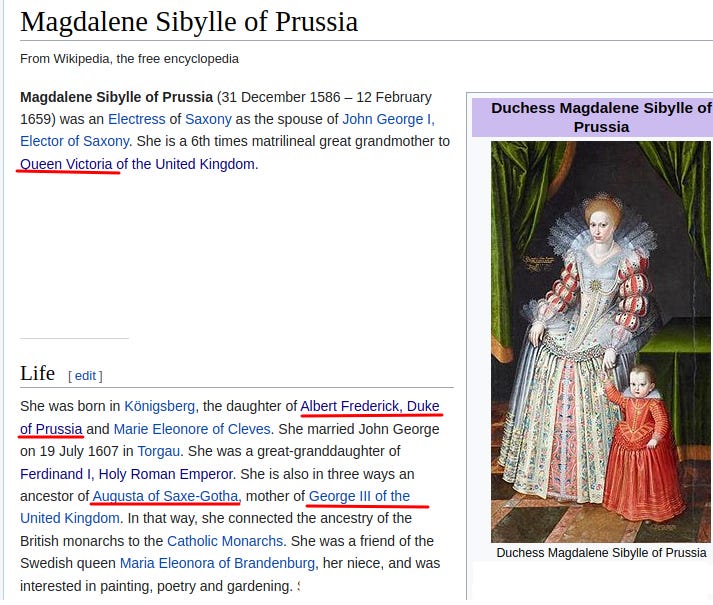
Just as Klaus Schwab likes to brag about his “penetration into national-government cabinets”, the House of Hohenzollern were penetrating royal families all over Europe, for centuries. The historic infiltration by the Hohenzollern royals was significant, and it seems that Klaus was acknowledging that the World Economic Forum is using the same playbook.
King Charles III was born to Elizabeth and Philip in 1948, and became the heir to the British Crown. We have dissected Elizabeth’s Prussian ancestry, but Philip’s line is just as interesting. He is a descendent from the Battenberg (now Mountbatten) family:
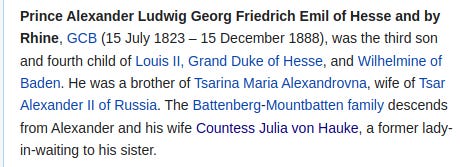
Prince Philip is Prince Alexander’s grandson. Interestingly, Philip’s uncle was the king of Greece, who was married to Kaiser Frederick III’s daughter, Sophia of Prussia.
Another uncle of Prince Philip’s, Prince Alexander of Battenberg, served as a lieutenant in the Prussian life-guards. He later became the Prince of Bulgaria and sought permission to also marry Kaiser Frederick III’s other daughter, Viktoria of Prussia. While Frederick III approved the marriage, it was later overruled and did not eventuate.
Prince Philip’s family were spread throughout European nobility, and some were not shy about their Nazi affiliation:
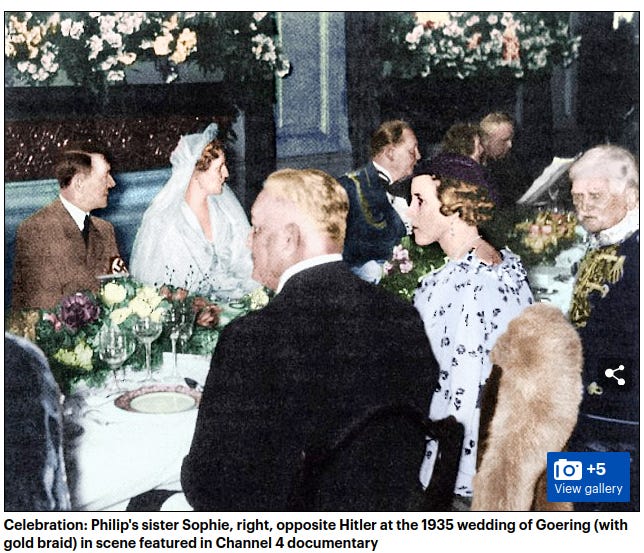
Researching the ancestry of Royal families is a tedious task. However, at every turn we seem to come across a member of the House of Hohenzollern, and this is not limited to the British royal family. As we shall soon discover, the Prussians were everywhere.
Vlad the Impaler
It is quite difficult to ascertain exactly who’s who in royal circles. However, it can be confidently stated that Charles is related to the Hohenzollern. When it comes to family heritage, Charles is not as impressed by his deep Prussian roots as much as he is with his ties to Romania and his connection to Vladislav III, who is better known as Vlad the Impaler, or Dracula. (0:13 seconds)
https://www.youtube-nocookie.com/embed/_g2Zu9af5Ww?rel=0&autoplay=0&showinfo=0&enablejsapi=0
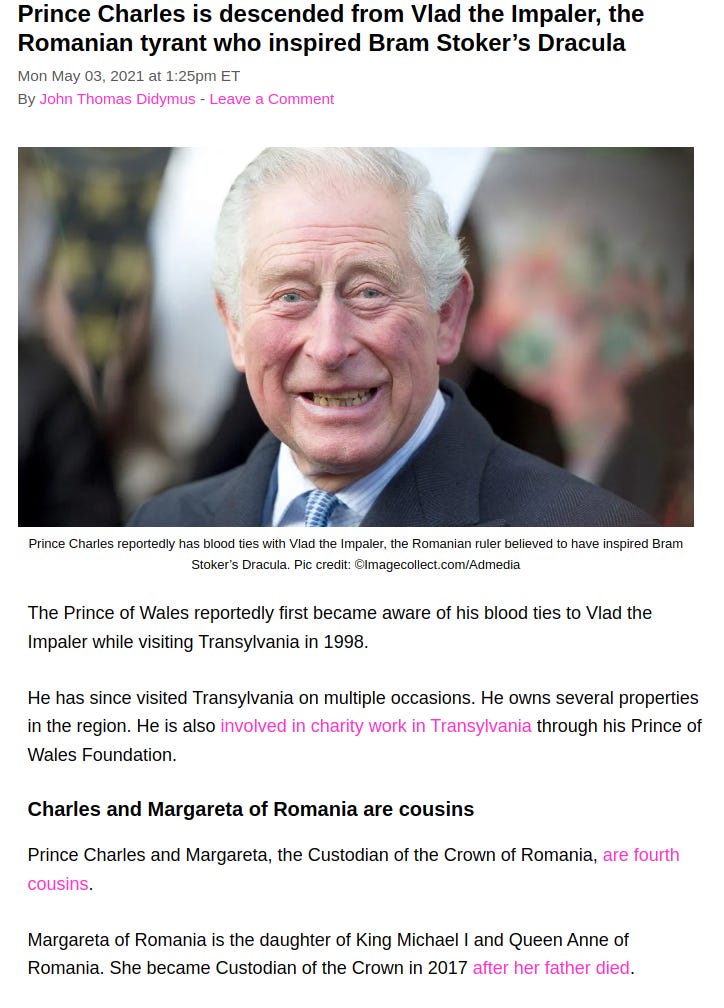
Before we embark on a journey to Transylvania, the relation between Charles and Margareta is important to note. We have consistently stated that the Hohenzollerns were the kings of Prussia, Kaisers of Germany, and the princes of Orange. However, they were also the kings of Romania. Margareta is from the House of Hohenzollern, and Charles’ fourth cousin:
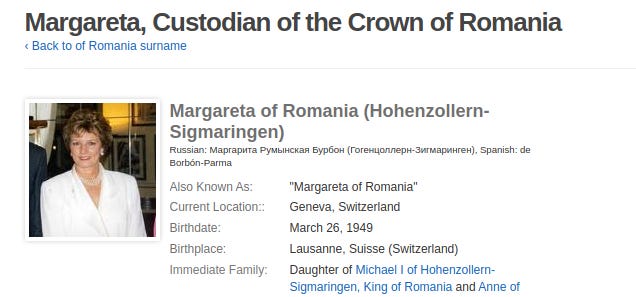
Having connected the Romanian royals with the House of Hohenzollern, let’s get back to Vlad.
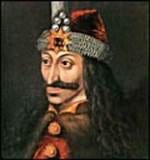
Vlad the Impaler lived in extremely hectic times. Living in 15th Century Romania was no picnic, especially for nobility.
The Turks, led by fearless leaders like Mehmed II, were a force to be reckoned with on the Eastern front. Every year the Turks would ask for 500 Romanian boys to be sent to the Turkish Janissary corps. They would also demand tribute in gold and silver from the Romanian kingdom. Failure to comply would be met with war and bloodshed.
The threat faced by the Turks (or Ottomans) represented an existential threat to the West and to Christendom. This was not lost on the rulers of the day, and Eastern Europe required the toughest, most brutal warriors to ‘hold the line’. Dracula’s family met this requirement perfectly:

Dracula embarked on a vicious war campaign:
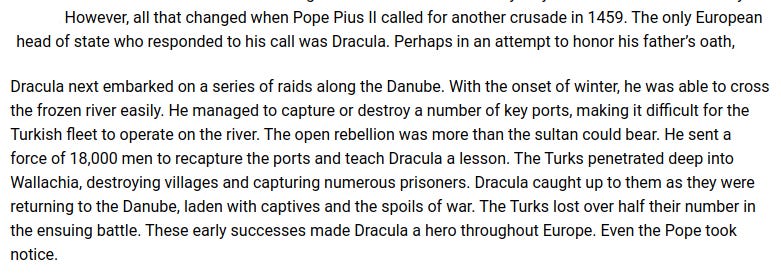
The conquests of Vlad have him embedded in Romanian folklore as a hero, and many Romanians treasure the vicious assaults he made against the enemy:
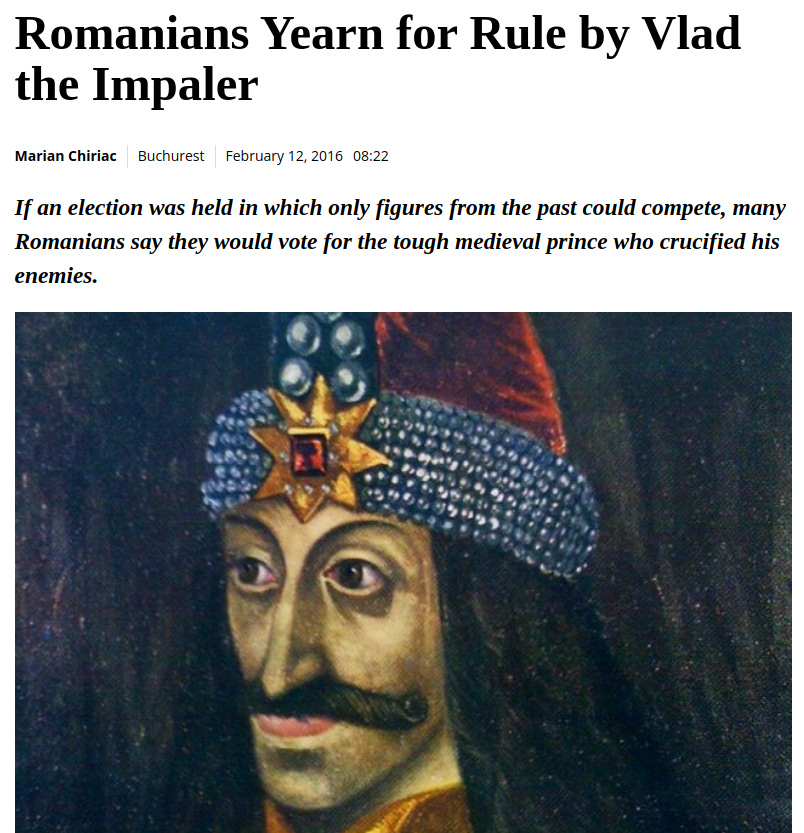
The brutality of Vlad the Impaler is well documented. He was even known to boil people, but his favorite method of torture and execution was impaling, which could take days before the victim actually died:
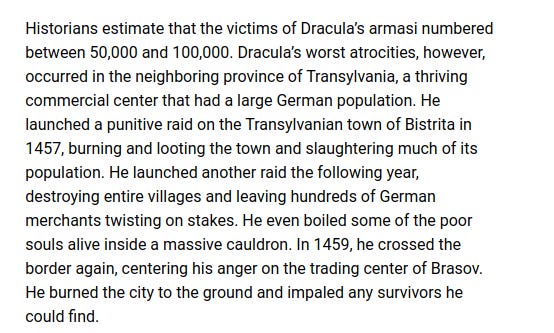
Vlad seemed to take pleasure in knowing his victims suffered as long as possible. When impaling large amounts of people, it was rumored he liked to have a table set up so he could enjoy a feast while men, women and children died in front of him.
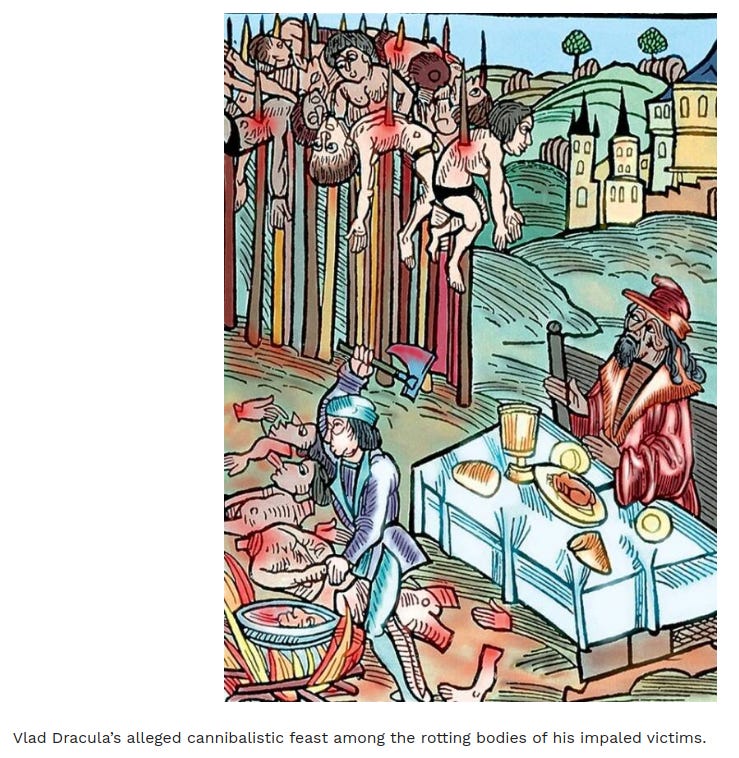
There is no doubt Vlad the Impaler played a significant role in defending the West against the Ottoman Turks, and for that he is revered by his nation. There is no doubt that his techniques to enforce the rule of law were so abhorrent that the legend of Dracula may even be understated. There is also no doubt that Charles is the current heir to Dracula’s bloodline:

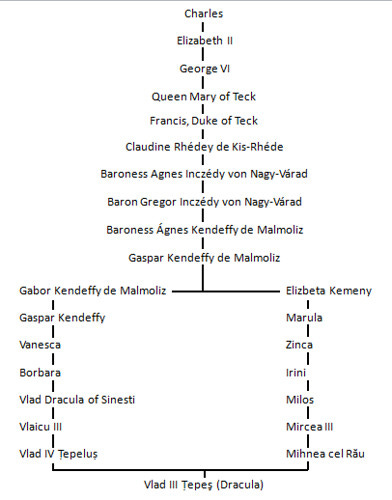
When talking about his bloodline link to Dracula, Charles did say, “… I do have a bit of a stake in the country”. Well, on this issue Charles isn’t just talking the talk; he is walking the walk. Charles is investing significant money into the region to try and preserve the natural beauty of Transylvania. His efforts have been duly recognized by local government:
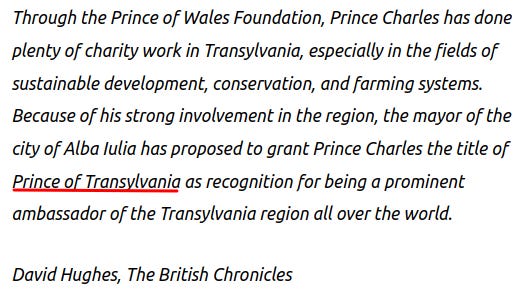
The Prince of Transylvania is an interesting title, especially now that we know the House of Hohenzollern still maintain custody of the title “Kings of Romania”. If the titles were a true claim to Romania, it would mean Charles, Prince of Transylvania from the House of Windsor, would be loyal to the Queen Margaret of Romania, from the House of Hohenzollern.
This detail will be important to remember as we investigate the origins of the Order that Dracula’s father pledged an oath to.
The Order of the Dragon
Societas Draconistarum, or The Order of the Drago,n was formed by the Holy Roman Emperor Sigismund:

The origins of the name ‘Dracula’ stem from the family’s association with the secret Order of the Dragon:
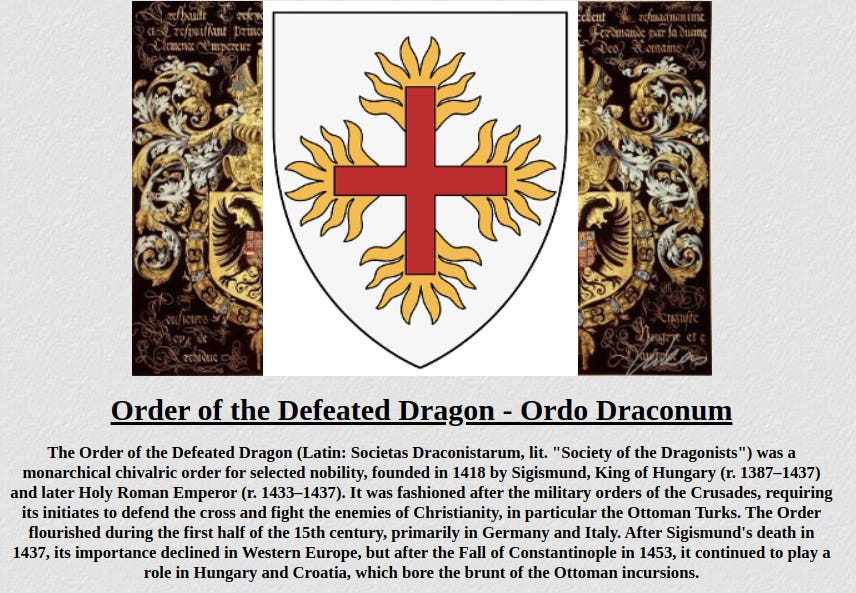
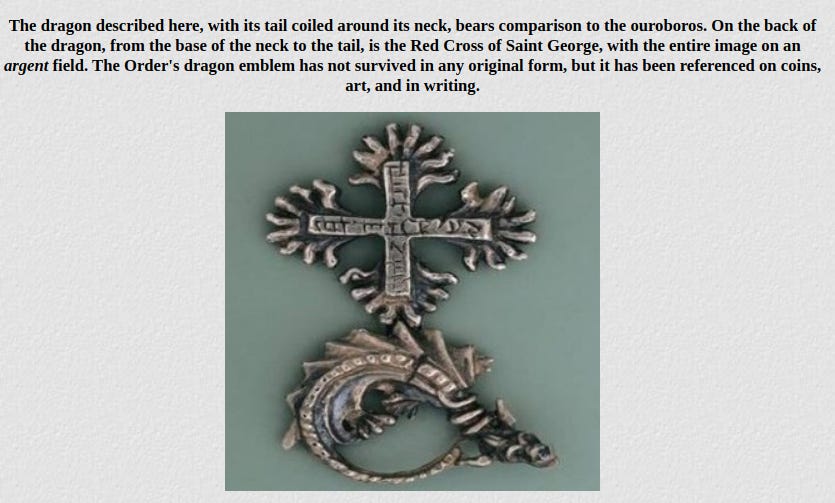
Recall in ReichsWEF Part V, how the Red Cross was used to aid the Nazi cause, and that Klaus Schwab’s namesake, Martin Bodmer, was Vice President of the International Committee of the Red Cross.

The Dragon’s link to the Red Cross of St. George is interesting. It is also highly coincidental that the modern-day Red Cross offered significant help to the fleeing Nazis after World War II. However, what is most relevant to us here is the oath taken by the Dracul family to the Order of the Dragon. Vlad the Impaler considered the oath to be hereditary:

Vlad took his oath very seriously and considered it as part of the family bloodline. Now that Charles has inherited Vlad’s bloodline, as the 16th great grandson, it is hard to fathom that this family oath to the secret Order of the Dragon is still in play. Most people would doubt that Charles even knows about this oath to the Order of the Dragon, let alone whether he takes it seriously.
Let’s continue the story: In 1969, Charles was crowned the Prince of Wales.
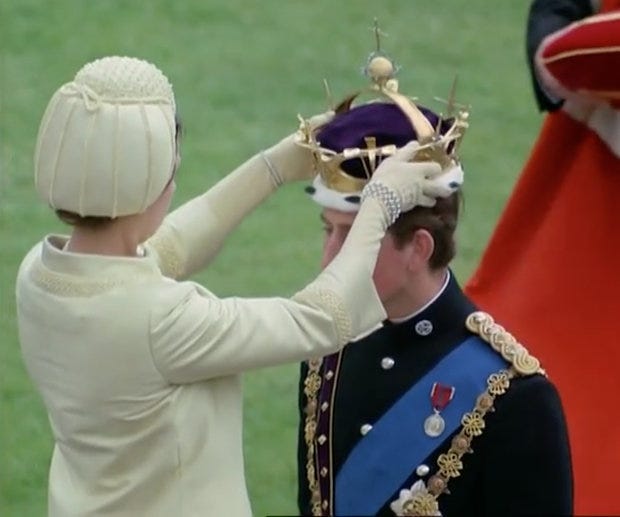
This coronation was a significant event in Charles’ life because it symbolized that he would become the heir apparent to the British throne. Charles took the occasion very seriously, and in his address, he spoke in English and in Welsh.

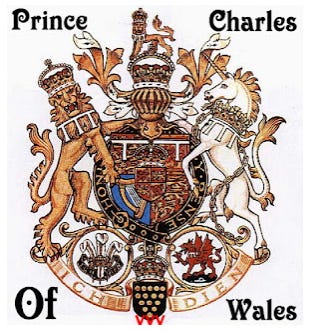
On the lower right-hand corner of Prince Charles’ emblem is the national symbol of Wales which is a red dragon. The motto on the emblem reads “Ich Dien”, which is German for “I serve”. This declaration will be important to remember as we continue to explore Charles’ heritage.
To be fair, these symbols and statements are fairly generic and not uncommon in history. The Welsh dragon and the Order of the Dragon could simply be a coincidence. However, Charles did take the dragon very seriously at his own wedding. He was suitably pissed when the dragon did not appear on his cake:

Another point of interest is the connection between Wales and the lands that Dracula ruled over; which was known as Wallachia:
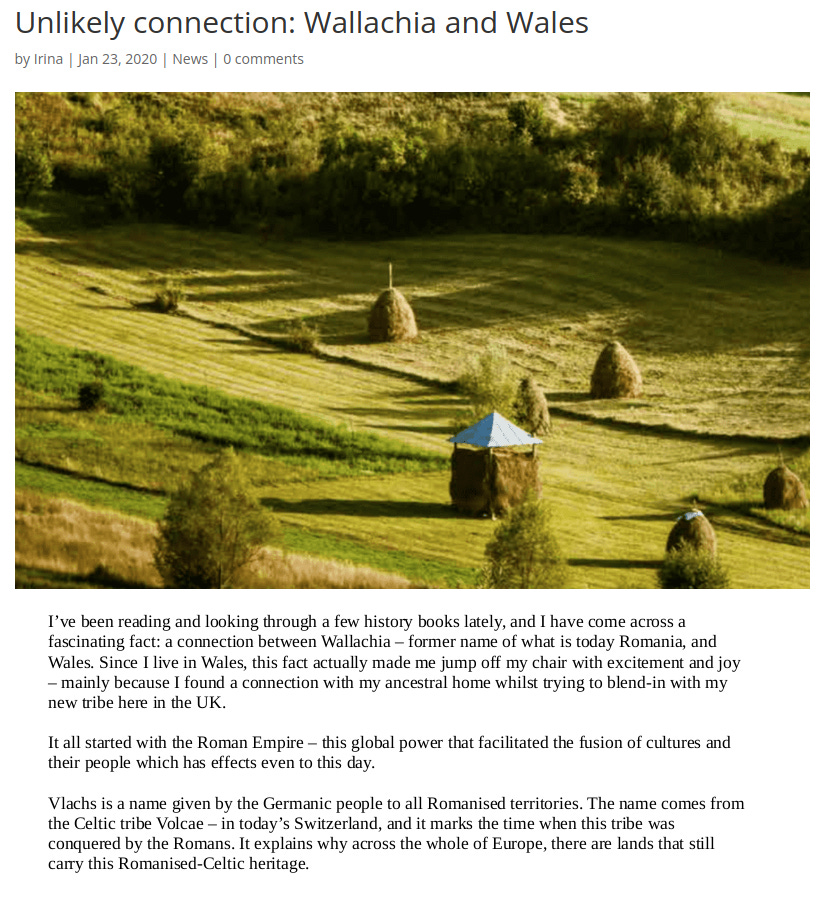
The potential connection between Wales and Wallachia is fascinating, especially when one considers that the Welsh language is a branch of the Romani language, and the Romani people are one of the largest minorities in Romania. It may also explain why Charles, the Prince of Transylvania, spends so much time in his beloved Transylvania.
While the custody of the Crown of Romania remains in the hands of the Hohenzollerns, it is time to investigate the origins of the Order of the Dragon, and the Holy Roman Emperor behind it all.
Sigismund and the Pawn Broker
Holy Roman Emperor Sigismund was the man who founded the Order of the Dragon. He demanded that every member pledge an oath of loyalty to him, and to defend Christendom. This creates a direct connection between the Holy Roman Empire and the Order of the Dragon. As we have established, Vlad the Impaler upheld that oath to the Dragon which his father had taken, and potentially created a system whereby loyalty to the Holy Roman Emperor and the Order of the Dragon would be passed down through bloodline. Charles has now inherited that bloodline, but whether or not the oath is carried on, we don’t know.
Recall that the Prince of Wales emblem contains the German pledge “I serve”. Who is honored by this oath to serve? For Vlad the answer was simple; he served the Holy Roman Emperor:

In a chaotic in-family battle, it was Sigismund who took the role of Emperor in 1433:
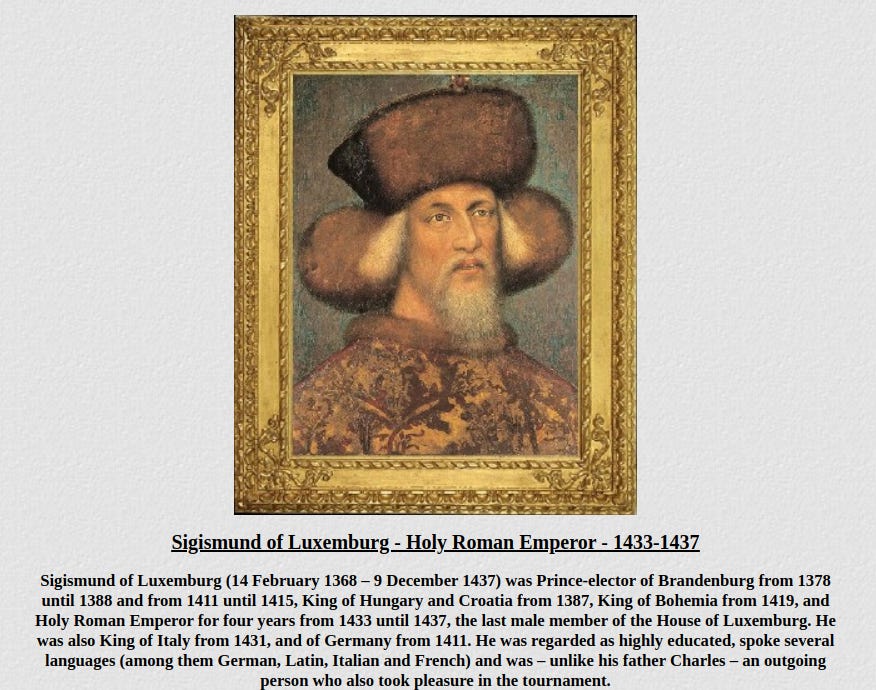
Sigismund’s older brother, Wencelslaus, was the Emperor from 1378-1400 before being dethroned by Ruprecht III. Ruprecht (or Rupert in English) then formed an alliance with Wencelslaus’ cousin Jobst, and were pitched against Wencelslaus and Sigismund in a three-way battle for the throne:

After this turbulent period, Sigismund had become the King of the Romans – the Holy Roman Emperor. Throughout all the chaos, one man stood with Sigismund and gave him all the support he needed to become the Holy Roman Emperor:
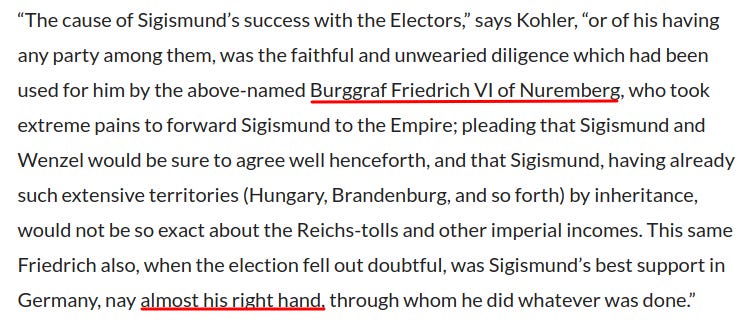
Friedrich VI, Burgrave of Nuremberg, was from the House of Hohenzollern:
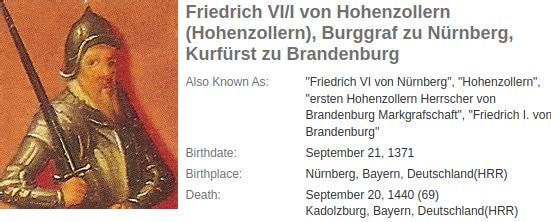
As Holy Roman Emperor, Sigismund was very busy. Not only had he founded the Order of the Dragon, he was embroiled in the Hussite Wars and trying to reform the church at the Council of Constance. All of these initiatives would have required some serious funding. This was money which Sigismund did not have. His “right hand man” Friedrich came to the rescue, and offered him letters of credit!!! These loans were not without sufficient collateral. Friedrich’s terms were clear, the Holy Roman Emperor Sigismund had to pledge the Electorate of Brandenburg as collateral. The Emperor had just been placed in debt to the House of Hohenzollern:
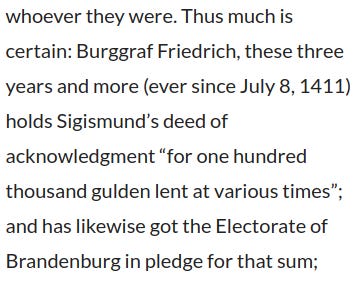
While Kaiser Sigismund was grateful for the finances, it was not enough to maintain his desired standard of living as the Holy Roman Emperor. The financial situation Sigismund found himself in was brutally explained by Friedrich:
“The like, with still more emphasis, did Sigismund, or Burggraf Friedrich acting for him: “Sigismund, sure, is Kur-Brandenburg, though under pawn!” argued Friedrich”
Friedrich was unashamedly acting as pawn broker for the Emperor. Eventually, with the loans piling up, Sigismund was left with no choice:
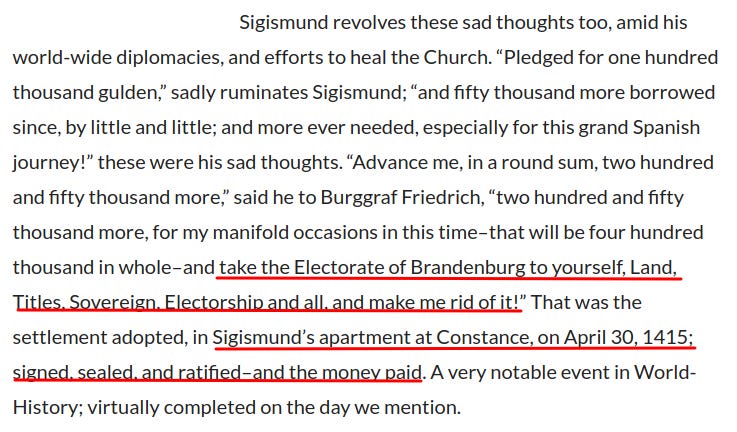
This is possibly the greatest transaction in history, which established the House of Hohenzollern as the Margraviate of Brandenburg in what was really, a forced liquidation. Drowning in the debt owed to the Hohenzollern, The Holy Roman Emperor found himself with no other choice but to hand over Brandenburg to his pawn broker, Friedrich.
It is an incredible story and marks the beginning of the meteoric rise of the Hohenzollerns. Incredibly, there is still more to this story.
The Holy Roman Empire had granted the Hohenzollern’ their titles in Zollern and Nuremberg. Now we see that Sigismund, the Emperor of the Holy Roman Empire, had just handed Brandenburg to the same family. The Holy Roman Empire founded the Hanseatic League, and Sigismund founded the Order of the Dragon. The Hohenzollerns, Hanseatic League and the Order of the Dragon all had one thing in common: They had to pledge their allegiance to the Holy Roman Emperor, otherwise known as the “King of the Romans”:

The actual title throughout the ages varied from time to time, but the German king, or Kaiser, generally sought the title of Holy Roman Emperor. The Empire came to an end in 1806, marking 1000 years of rule, and came to be known as the ‘First Reich’:
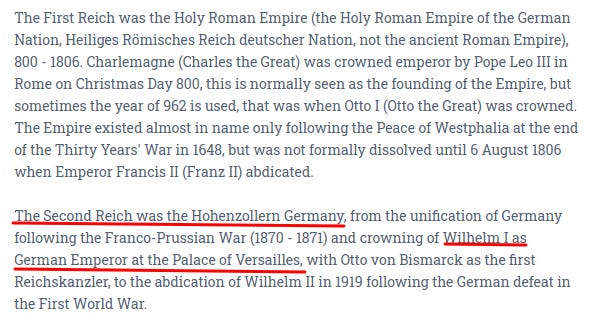
By 1871, the title of Kaiser, or Emperor, had been handed to the House of Hohenzollern. In our Not Since 1917 series, we went to great lengths to present evidence that Prussia did not disappear, but instead followed the same patterns as the Hanseatic League and Teutonic knights before them, and morphed into the ‘horrible invisible enemy’.
#PrussiaGate has not yet been able to find a hidden Kaiser of a hidden empire, however we have shown that the Kaiser of Germany, Kings of Prussia, Kings of Romania and Princes of Orange have disappeared from the world diplomatic stage, but all of these titles remain current; resting with the heirs of the House of Hohenzollern.
While we may not have been able to give a name to a hidden ruler of a hidden kingdom, the presence of such a powerful regime has long been talked about:
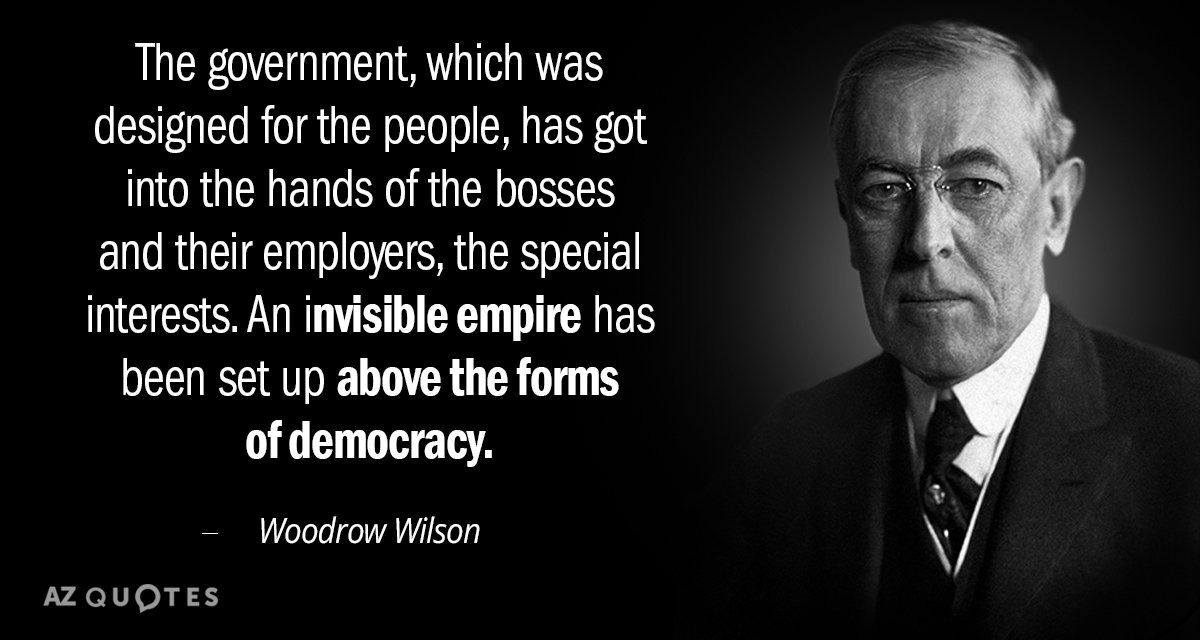
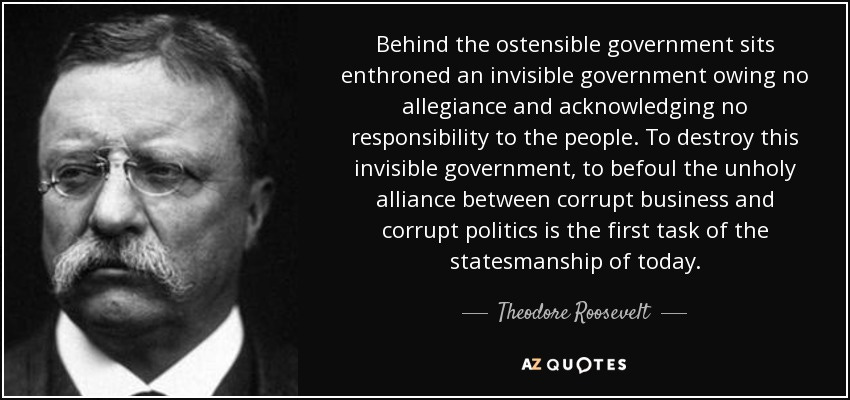
Let’s Summarize:
The British Royal family are intricately linked with the House of Hohenzollern. The new King Charles III has also claimed direct lineage to Vlad III the Impaler, otherwise known as Dracula. Charles has inherited the bloodline of Dracula, who maintained the family’s oath to the Order of the Dragon, potentially revealing that a hereditary oath is taken by the heir of this bloodline. The Order of the Dragon was founded by Kaiser Sigismund and members must pledge their allegiance to the Holy Roman Emperor.
In 1969, Charles was crowned Prince of Wales, developing a fondness for the Welsh Red Dragon. Wales is historically tied to Wallachia (Romania), the same lands that Vlad the Impaler ruled, and the Welsh-Romani language is similar to other Romani peoples. Romani remain one of the largest minorities in Romania and Charles feels very comfortable in Transylvania:
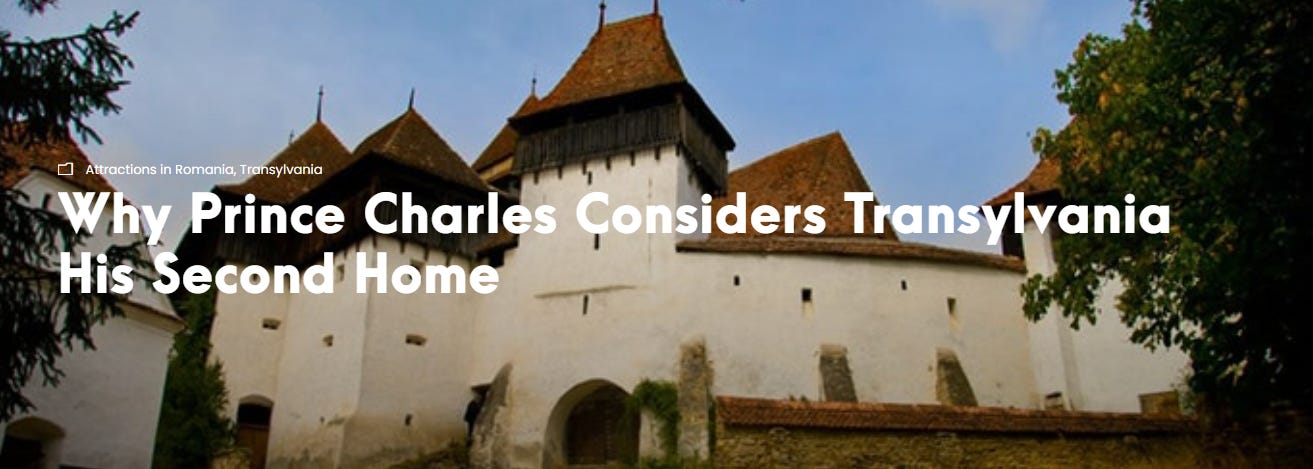
Holy Roman Emperor Sigismund’s right-hand man was Friedrich VI, Burgrave of Nuremberg, of the House of Hohenzollern. Friedrich acted as pawn broker to the Emperor, and when Sigismund couldn’t cough up the money, the Elector of Brandenburg was handed to Friedrich and remained in the House of Hohenzollern for centuries thereafter.
The Hohenzollerns began their meteoric rise to power from that moment on. While every other European royal dynasty waned in power and stature, the Hohenzollerns expanded and consolidated. The apex of their power was in 1871 when Wilhelm I was crowned Kaiser of Germany. This title was generally reserved for the Holy Roman Emperors, which was dissolved in 1806. The Hohenzollern Kaisers marked the beginning of the “Second Reich”.
If Roosevelt and Wilson are correct, and there is an “invisible empire” in which a Kaiser remains enthroned, it could explain why so many royals maintain their titles, and are so invigorated by all the pomp and ceremony that goes with it. The people’s tax dollars fund these traditions, are we are told that this is all for the celebration of history. #PrussiaGate is not so sure.
Regardless, this ‘Ode to the Prussian Pickle’ journeys through Charles’ fascinating heritage. We are beginning to understand why royal pomp and ceremony is one of his keen passions, along with Transylvania.
The Coat of Arms for Transylvania is full of Prussian symbolism, and a shout-out to the seven Saxons, being people of German ethnicity who were settled in Transylvania in waves starting from the mid-12th century until the mid-19th century:
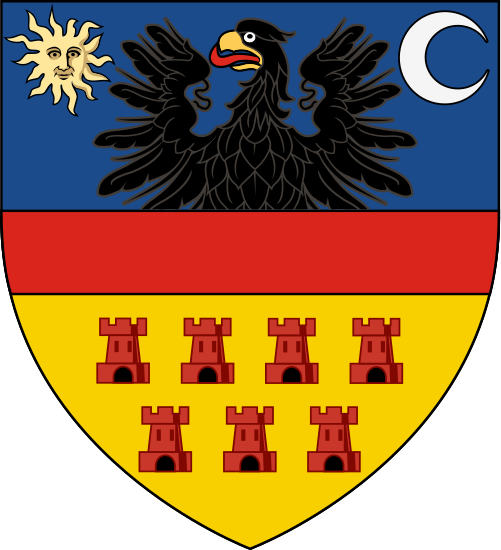
Charles’ connection to Romania is highly unique and his passion for the nation is acknowledged.
We will sign off this article by combining Charles’ passion for Romania with another endeavor he equally supports – Espionage, and the now-famous Romanian hacker:
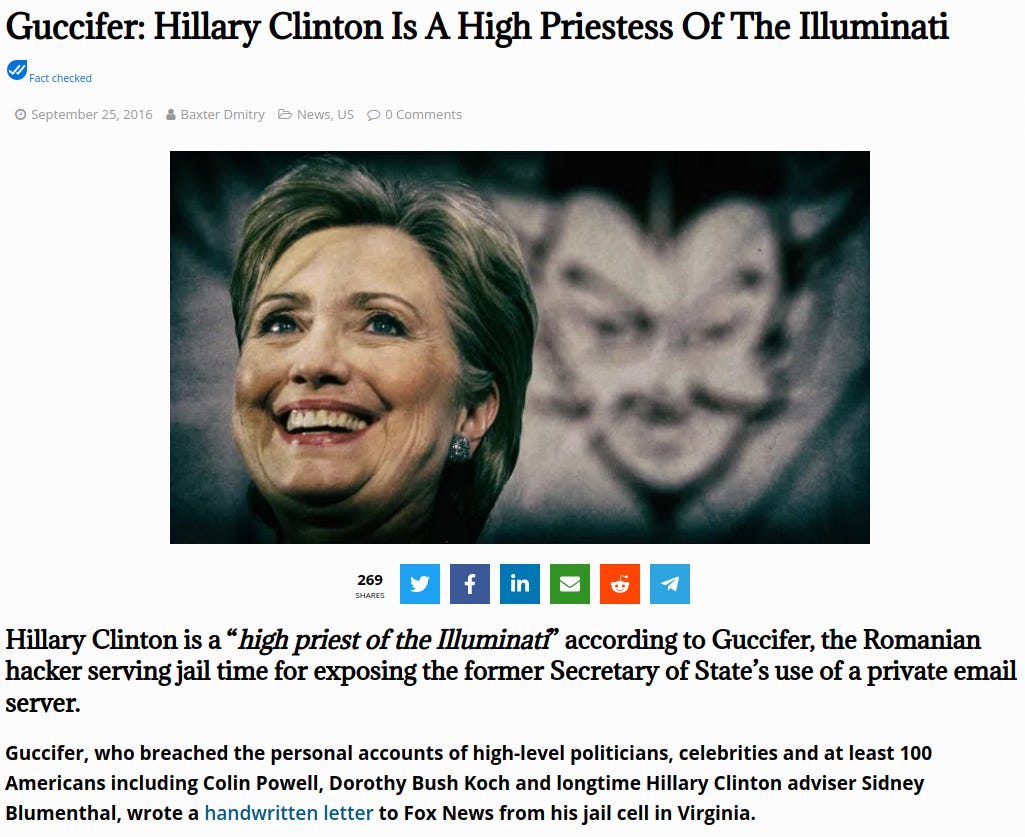
to be continued…………
https://www.worldhistory.org/Glorious_Revolution/
https://en.wikipedia.org/wiki/Magdalene_Sibylle_of_Prussia
https://en.wikipedia.org/wiki/Prince_Alexander_of_Hesse_and_by_Rhine
https://www.geni.com/people/Margareta-Custodian-of-the-Crown-of-Romania/6000000003215703226
https://warfarehistorynetwork.com/the-origins-of-dracula-vlad-the-impaler/
https://balkaninsight.com/2016/02/12/romanians-would-welcome-authoritarian-leadership-02-11-2016/
https://warfarehistorynetwork.com/the-origins-of-dracula-vlad-the-impaler/
https://allthatsinteresting.com/vlad-the-impaler
https://warfarehistorynetwork.com/the-origins-of-dracula-vlad-the-impaler/
http://www.holyromanempireassociation.com/order-of-the-dragon-Ordo-Draconum.html
https://warfarehistorynetwork.com/the-origins-of-dracula-vlad-the-impaler/
https://en.wikipedia.org/wiki/Coat_of_arms_of_the_Prince_of_Wales
https://thecommunitariantrap.blogspot.com/2013/04/who-is-controlling-world-putting-it-all.html
http://www.holyromanempireassociation.com/list-of-holy-roman-emperors.html
http://www.holyromanempireassociation.com/list-of-holy-roman-emperors.html
https://en.wikipedia.org/wiki/Wenceslaus_IV_of_Bohemia
https://historyweblog.com/2014/04/house-of-luxemburgs-triump/
https://www.geni.com/people/Friedrich-I-Kurf%C3%BCrst-von-Brandenburg/4786136463460024221
https://historyweblog.com/2014/05/brandenburg-sold/
https://historyweblog.com/2014/04/house-of-luxemburgs-triump/
https://historyweblog.com/2014/05/brandenburg-sold/
https://en.wikipedia.org/wiki/King_of_the_Romans
https://newspunch.com/guccifer-hillary-clinton-high-priestess-illuminati/
